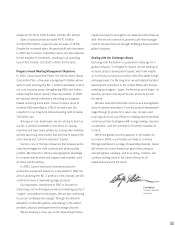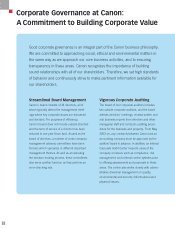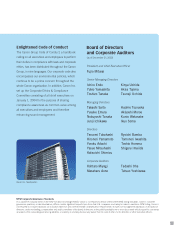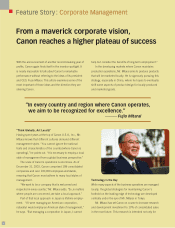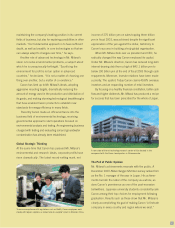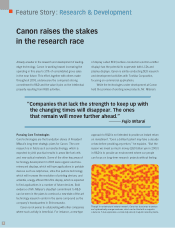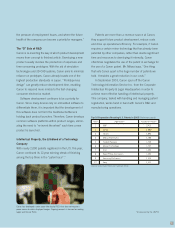Canon 2003 Annual Report Download - page 15
Download and view the complete annual report
Please find page 15 of the 2003 Canon annual report below. You can navigate through the pages in the report by either clicking on the pages listed below, or by using the keyword search tool below to find specific information within the annual report.
would be eliminated annually as a result of a change in
transportation policy. By using an efficient new rail container
system, jointly developed with Nippon Express and Japan
Freight Railway Company, Canon will take traffic off the
roads between Tokyo and Osaka, and thereby cut the
associated truck exhaust emissions.
Canon has long been an industry leader in the recycling
of laser and inkjet cartridges and other consumable items,
as well as in the actual materials used for production and
packaging of its goods. In 1990, Canon pioneered the
collecting and recycling of used toner cartridges, and in
the years since has been responsible for the recycling of
over 120,000 tons of those cartridges. Today, the toner
cartridges Canon collects are 100% recycled in four
facilities worldwide.
Smart Technology
In one of his many aggressive statements on corporate
environmental responsibility, Canon president and CEO
Fujio Mitarai stated: “Technology and industry have
destroyed nature. It is up to technology to solve environ-
mental problems.”
Canon’s development engineers have given truth to
Mr. Mitarai’s words, especially in the area of energy
conservation. Color IH Fusing technology, which warms
only the area necessary for toner fusing, cuts down the
warm-up time, and hence the energy consumption, of
copying machines and laser beam printers.
On the inkjet printer front, even more dramatic improve-
ments are underway. Canon’s research is already showing
results: A 2003 model of one Bubble Jet printer consumes
76% less power than its 2001 counterpart.
Responsibility, Top to Bottom
While Canon’s organizational structure allows streamlined
environmental assessment and the rapid implementation of
appropriate actions, Mr. Mitarai’s leadership of Canon has
driven the company towards industry-leading moves. A good
example took place in June 2003 when Canon invited 80
Tokyo analysts to its Tokyo corporate headquarters to listen
to a full report on the company’s environmental strategy.
Mr. Mitarai has proclaimed that “sacrificing the envir-
onment for profit is not an option in advanced countries.”
Canon, as it has for years, continues to back up his strong
words with bold actions.
Presentation of Canon’s environmental strategies to analysts at Canon
headquarters
The fully automated Canon Ecology Industry Inc. facility in Japan is one of four
plants worldwide that Canon operates for the recycling of used toner cartridges.
13


